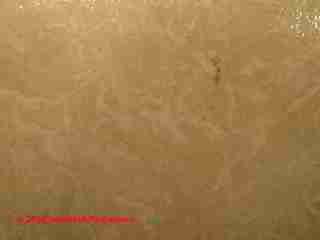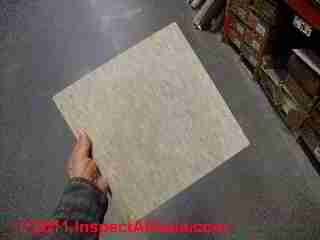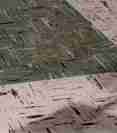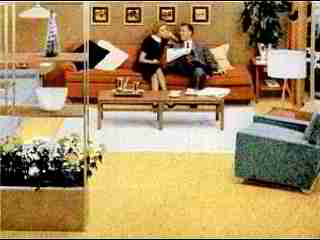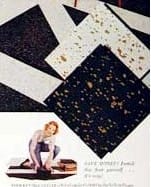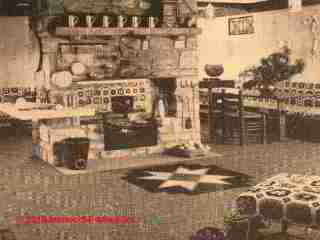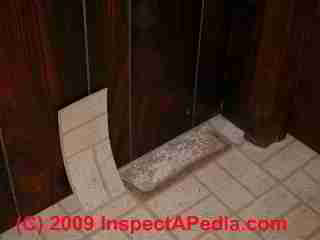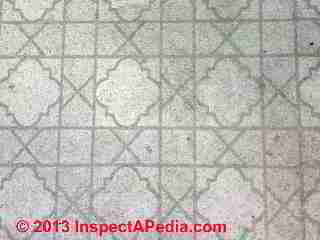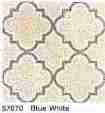 Asphalt or Vinyl Asbestos Floor Tiles Product History and Product Name List
Asphalt or Vinyl Asbestos Floor Tiles Product History and Product Name List
- POST a QUESTION or COMMENT about how to identify brands & types of vinyl & vinyl-asbestos floor tiles & sheet flooring & about the asbestos content of these products
Identify vinyl or asphalt-asbestos flooring by brand name & image:
Photo guides to asphalt asbestos and vinyl asbestos floor tiles, 1900 -1986: this article provides a guide to identifying asphalt-asbestos flooring (1917 - ca 1960) & vinyl asbestos floor tile (ca 1952 - 1986):
identification photographs, product names, styles, colors, and vinyl-asbestos floor patterns, and colors for asbestos-containing floor tile products made between about 1930 and 1986 - flooring materials that are reported to or have been confirmed to contain asbestos in asbestos fiber or asbestos powder-filler form. These flooring products typically contain chrysotile asbestos, and possibly other asbestos forms.
InspectAPedia tolerates no conflicts of interest. We have no relationship with advertisers, products, or services discussed at this website.
- Daniel Friedman, Publisher/Editor/Author - See WHO ARE WE?
Vinyl Asbestos Floor Tiles Product History and Product Name List
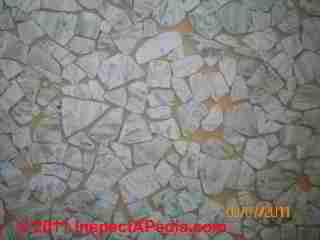
Sorting out Flooring Names: Armstrong, Congoleum-Nairn, Linoleum, Lincrusta
This photograph of sheet flooring was identified by a reader in a 1964 home. She found remnants in the bottom of a kitchen cabinet on which was imprinted "Armstrong". While the reader referred to this as "Armstrong Congoleum sheet flooring", Armstrong and Congoleum are separate individual companies.
The sheet flooring shown above is identified as an Armstrong resilient flooring product. A sample of this resilient flooring was tested and confirmed a 70% asbestos content.
[Click to enlarge any image]
Dont' mix up product names. Armstrong is a separate company from Congoleum-Nairn.
Linoleum is a term invented in 1860 by Frederick Walton to describe sheet flooring. Original linoleum products were made using linseed oil as an ingredient, often with a jute (burlap or fabric) backing. Descendents of Linoleum include Anaglypta and Lincrusta (many writers spell it "Linocrusta or linacrusta", an embossed patterned covering used on walls and ceilings.
NOTE: Armstrong, although an enormous producer of flooring, was by no means the only manufacturer of floor covering products that contained asbestos as fibers or asbestos powder filler. Below we provide photographs and descriptions from a variety of flooring manufacturers, followed by a detailed list of floor tile product names we've been able to collect.
You'll note that the Armstrong product list extends from 1954 to the late 1980's. Other asbestos-containing flooring products from various manufacturers were produced between around 1920 to 1986.
Amitco International, another larger producer of floor tiles has operated from 1964 to the present. Amico flooring is discussed
at AMITCO ASBESTOS FLOOR TILES.
How to Find Your Floor Tile or Sheet Flooring in this Flooring Reference Photo Guide
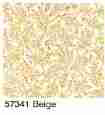
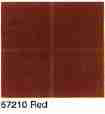
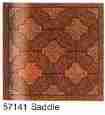
Asphalt asbestos and vinyl-asbestos floor tiles were produced in 9" x 9", 12" x 12", and even 18" x 18" as well as in decorative strips, and in thicknesses of 1/16", 3/32", and 1/8", also in 0.08 gauge. Some sheet flooring or resilient flooring also contained asbestos, as did floor tile mastics.
This photo guide to asphalt asbestos & vinyl asbestos floor tiles for each year shows at least one color photo of each floor tile style or pattern in an example color. A list below each group of photos includes the names of and links to additional photos for other colors of these styles.
Asbestos is safe and legal to remain in homes or public buildings as long as the asbestos materials are in good condition and the asbestos can not be released into the air.
To identify a particular asphalt-asbestos or vinyl-asbestos floor tile pattern & color, start in the image group most likely to be the same age as your building.
If you don't find your floor tile or sheet flooring by looking forward from that that year, you should also look backwards in the earlier years as your specific flooring pattern & color may have first appeared in an earlier year. For other tile brands than Armstrong, see the brand name floor tile links included in this list.
If you can identify your floor tile collection name or model number, or if you recognize it in the extensive library of flooring color and pattern photographs provided in these pages, laboratory testing of the sample to screen the flooring for asbestos may be unnecessary. Our home page for asbestos-containing floor tiles is
at ASBESTOS FLOOR TILE PHOTO ID GUIDE
To send us photographs of possible asbestos-containing flooring that you are trying to identify, use the email address found at CONTACT.
We have split this guide to Armstrong Asphalt Asbestos or Vinyl Asbestos Floor Tiles into the individual year range pages (dates of production) below in order to cut web page load time.
- ASBESTOS FLOOR TILE IDENTIFICATION PHOTOS 1949-1959 - home: photo guide
- FLOOR TILE HISTORY & INGREDIENTS
- AMITCO ASBESTOS FLOOR TILES
- ASBESTOS TEST RESULTS for TILE & SHEET FLOORING - confirmation by lab tests or documents
- ARMSTRONG FLOOR TILE IDENTIFICATION - 1951 - 1986 asbestos
- ARMSTRONG CORLON FLOORING
- ARMSTRONG FLOOR TILE IDENTIFICATION PHOTOS 1951-1954 - Excelon & Others
- ARMSTRONG FLOOR TILE IDENTIFICATION PHOTOS 1955
- ARMSTRONG FLOOR TILE IDENTIFICATION PHOTOS 1956-1957
- ARMSTRONG FLOOR TILE IDENTIFICATION PHOTOS 1958-1959
- ARMSTRONG FLOOR IDENTIFICATION PHOTOS 1960-1969
- ARMSTRONG FLOOR TILE IDENTIFICATION PHOTOS 1970-1972
- ARMSTRONG FLOOR TILE IDENTIFICATION PHOTOS 1973, COMPLETE GUIDE
- ARMSTRONG FLOOR TILE IDENTIFICATION PHOTOS 1974 - 1979 complete
- ARMSTRONG FLOOR TILE IDENTIFICATION PHOTOS 1975-1976-1977
- ARMSTRONG SOLARIAN FLOOR TILE 1978
- ARMSTRONG FLOOR TILE IDENTIFICATION PHOTOS 1979
- ARMSTRONG FLOOR TILE IDENTIFICATION PHOTOS 1980-1988
- ARMSTRONG ACCOFLEX FLOORING & TILES 1989 & LATER
- CONGOLEUM-NAIRN FLOOR TILES & LINOLEUM
- DOMINION & Other CANADIAN FLOORING ASBESTOS
- GOODYEAR ASBESTOS FLOOR TILES
- EVER-WEAR ASBESTOS FLOOR TILE GUIDE
- KENTILE KENFLEX ASBESTOS FLOOR TILE GUIDE
- LINOLEUM SHEET FLOORING GUIDE
- MASTIC, CUTBACK ADHESIVE, FLASHING CEMENT ASBESTOS
- MONTGOMERY WARD ASBESTOS FLOOR TILE IDENTIFICATION
- OWENS CORNING ASBESTOS-CONTAINING FLOORING: asbestos floor tiles, asphalt based or vinyl based?
Some mesothelioma websites cite Owens Corning as a producer of asbestos-containing floor tiles and "floor coverings" up to 1971;
we have not yet (Feb 2018) found specific asbestos-containing flooring products for this manufacturer.
Excerpts / adaptations from Fiberboard corporate history sources:
Fibreboard Corporation (California) operates in three primary business segments: vinyl siding manufacture, resort operations, and industrial insulation.
Owens Corning acquired Fibreboard Corporation in 1997. Fibreboard Corporation is reported to have also made asbestos-containing industrial insulation, floor coverings and other products from 1920 to 1971.
Fibreboard abandoned its asbestos products and business in 1972, principally an asbestos-containing fire retardant. The company suffered a disastrous financial loss due to asbestos-injury claims beginning in 1991 and in 1993 agreed to pay (through insurance coverage) $3 billion in claims.
During the mid-1990s, Fibreboard owned and operated Sierra-at-Tahoe and Northstar-at-Tahoe, two ski resorts in Lake Tahoe, California, a vinyl siding manufacturing and distribution business based in Ohio, and industrial insulation manufacturing facilities.
- sources:
Associated Press, "Owens Corning Will Buy FIbreboard", 29 May 1997, LA Times, Excerpt: Building materials manufacturer Owens Corning has agreed to acquire vinyl siding maker Fibreboard Corp. for about $600 million.
Funding Universe, retrieved 2018/02/07, original source http://www.fundinguniverse.com/company-histories/fibreboard-corporation-history/
"Fibreboard Reorganizes Wood Products Business," Forest Industries, September 1991, p. 6.
Levander, Michelle, "Calif's Fibreboard Agrees to Settlement of Record $3 Billion in Asbestos Suit," Journal of Commerce and Commercial, December 29, 1993, p. 7A
Other producers of adhesive-vinyl flooring made products containing asbestos that may have been sold into the early 1980's]
OCF Mastic, a flooring adhesive, however, was widely used to bond or glue commercial flooring products and contained asbestos fibers for strength and possibly asbestos powder filler for heat resistance. - RESILIENT SHEET FLOORING ID GUIDE
- RESILIENT VINYL or CORK FLOORING GUIDE
- SEARS ROEBUCK VINYL ASBESTOS FLOOR TILE RECOGNITION
- SELF-ADHESIVE PEEL & STICK ON ASBESTOS TILE IDENTIFICATION
- VINYL-ASBESTOS FLOOR TILE IDENTIFICATION PHOTOS
Many of the colors and patterns of asphalt-asbestos or vinyl-asbestos floor tiles were manufactured over many years and may appear in more than one of the floor tile photo collections listed by date range here.
For each year we list the names of the tile patterns sold during that year, we include representative color images of the floor tiles, and throughout the entire floor tile pattern & color history series we include each floor tile color & pattern of the floor tile in the first year that it appeared , and we include representative colors and patterns in other years.
Examples of floor tile packaging, labeling, and other information can be found throughout the flooring photo collections listed here.
Modern Armstrong 12"x12" x 1/16" (1.5mm) Self-Adhesive "Stick-on" Floor Tiles
Self-Adhesive Stick-on Tiles, Asbestos - peel and stick floor tiles that contain asbestos
Self-Adhesive Stick-on Tiles, Current - modern peel and stick floor tiles: information below.
This Armstrong flooring tile is 12" x 12" x 1/16" or 1.5mm thick.
Unlike the older vinyl-asbestos floor tiles whose photographs we provide below, this more recent flooring product is built from a thin vinyl layer containing the tile's design pattern and a fiber/paper backer (shown in our photo above) to which an adhesive was coated so that the tile could be installed without use of a mastic.
A typical pattern is the embossed design shown at left.
The floor tile thickness (about 1.5mm or 1/16") suggests that this product was produced after 1980 and probably does not contain asbestos.
Below we show a photo of the Armstrong© Stamp found on the under-side or "back" of 12 x 12 "stick-on" self-adhesive floor tiles produced by Armstrong.
Depending on the age of manufacture, some paper-backed flooring products used asbestos as a primary ingredient (see FLOOR TILE HISTORY & INGREDIENTS ).
Tests of our example floor sample (above) for asbestos confirmed that some early peel-and-stick floor tiles sold in the 1980's did contain asbestos.
Contemporary resilient flooring products do not contain asbestos however.
Shown at left: Armstrong Excelon Vinyl Floor tile, contemporary, popular, sold in 70 colors at retail outlets including Home Depot stores, this modern resilient floor tile does not contain asbestos. [Click any image to see an enlarged, detailed version].
A catalog of floor tile identification photographs for products that contained asbestos, 1952 - 1980, is provided below
at Armstrong Vinyl-Asbestos Floor Tile Photo ID Catalog - 1952 - 1986.
And at Armstrong flooring history we provide a history of Armstrong flooring and links to company information.
Contact Us to send a photograph of your own floor tile pattern or for assistance in identification if you can't find your floor tile image, pattern, or design in this floor tile color and pattern library.
Asphalt & Vinyl Asbestos based Floor Coverings & Floor Tiles 1900 - 1986
Asphalt resilient floor tiles Manufacturers, Brands, Styles, Photo Guide
Armstrong Asphalt Floor Tiles - 1950's to 1980's Compared to Contemporary Vinyl Flooring Products
Armstrong produced asphalt-based floor tiles, possibly including asbestos in their formulation, before 1952 and in later years as we indicate with examples and photographs in the detailed photo guide that is found below.
For more information about these older flooring types, see Asphalt & Vinyl Floor Tile History - history, dates, and description of the production process and ingredients in asphalt floor tiles, asphalt-asbestos floor tiles, & vinyl-asbestos floor tiles 1900 to present. Kentile flooring produced through 1986 may contain asbestos.
Also don't assume that only "vinyl asbestos floor tiles" include asbestos. According to Rosato, asbestos filler (powder) and fibers were used in asphalt based products too. "The first publicized installation of asphalt tile was in the Western Union office in New York City (1920). By the end of 1930, 3 million square yards of tile was being produced annually.
Below in this document we provide detailed year-by-year photos of Armstrong asphalt or vinyl-asbestos flooring products from 1952 to 1982. Records show that many but not all flooring products produced during these years, including 9" floor tiles, 12" floor tiles, peel-and-stick floor tiles, and sheet flooring indeed contain asbestos.
Later Armstrong flooring products, for example Armstrong's Accoflex 2005 series semi-flexible vinyl tile [PDF] sold (at least) in the U.K. were produced from " ground limestone bound with polymers, plasticizers, and stabilizers, and colored by pigments" not including asbestos.
At FLOOR, RESILIENT VINYL or CORK we discuss the choices, selection and installation details for contemporary vinyl and other resilient flooring products.
Guide to Armstrong Floor Tile Photographs
Sorry but the VAT (Vinyl Asbestos Floor Tile) photo catalog became so huge that the file was slow to load and unwieldy.
Scan through our images of asphalt asbestos or vinyl asbestos flooring, both tiles and sheet flooring) using the links below by starting at the earliest year that might pertain to your building or to when you think the flooring was installed. Because many floor tile patterns were produced over many years there is of course overlap among these year ranges.
- ARMSTRONG FLOOR TILE IDENTIFICATION - 1951 - 1986 asbestos
Styles, & Pictures of Congoleum-Nairn Vinyl-Asbestos Floor Tiles & Congoleum Linoleum Sheet Flooring: Resilient Floors
Details about Congoleum floor tiles and resilient sheet flooring and linoleum are found at CONGOLEUM-NAIRN FLOOR TILES & LINOLEUM. Excerpts are below.
Congoleum Nairn, was established in 1886, and presently headquartered in Mercerville, NJ, U.S., produced resilient sheet flooring, vinyl asbestos floor tiles in patterns such as their Congoleum-Nair Romanaire pattern.
Details about the history of Congoleum Nairn flooring are at Congoleum Flooring History and at FLOOR TILE HISTORY & INGREDIENTS.
Sequin Pattern for Congoleum resilient flooring is shown at left.
Congoleum Gold Seal Rugs along with Nairn Linoleum were marketed from the 1920's into the 1950's when Congoleum-Nairn was producing 12-foot wide sheet vinyl-based flooring.
Watch out: the backing on some of these vinyl flooring or linoleum products may also contain asbestos.
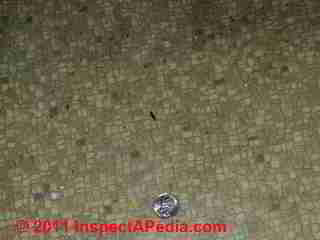
The Congoleum linoleum photograph (above) of Congoleum sheet flooring installed in a 1949 Tampa Florida home is provided courtesy of M.B. in Tampa, FL.
See CONGOLEUM-NAIRN FLOOR TILES & LINOLEUM for our complete set of photos and text about Congoleum Nairn flooring products that may contain asbestos.
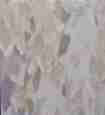
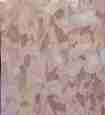
Photo Guide to Ever-Wear Vinyl-Asbestos Floor Tile
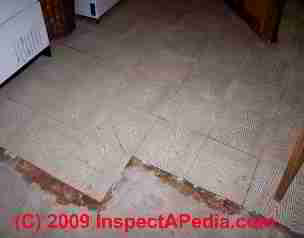

- Details of Ever-Wear flooring are at Ever Wear Flooring History. These photographs of EverWear Vinyl Asbestos floor tiles were provided courtesy of home inspector David Grudzinski,
Kentile Floors: KenFlex Asphalt-asbestos & Vinyl-Asbestos Floor Tiles - 1950's - 1980's Photo Guide
A detailed photo guide to identifying Kentile and KenFlex flooring is at KENTILE KENFLEX ASBESTOS FLOOR TILE GUIDE and Kentile history and dates are found at Kentile Flooring History. Excepts are below.
As we detail at Kentile Flooring History KenFlex floor tiles were produced by Kentile Floors, a Brooklyn NY company that filed bankruptcy in 1992. (founder Arthur Kennedy 1898) (at least) as 9" x 9" resilient flooring in a variety of patterns (left) and shades (below).
Kentile produced both Asphalt floor tiles using an asbestos filler (see our Rosato comment above), and Vinyl-Asbestos floor tiles. The dark floor tiles shown at left may have been asphalt-asbestos. If the floor tile is thicker than 1/16", particularly, 1/8" or more, we suspect you're looking at an asphalt based tile, rather than a later vinyl-asbestos floor tile.
(Additional Kentile floor covering photos wanted - CONTACT US)
Montgomery Ward Asbestos-Containing Floor Tiles, Photo Guide

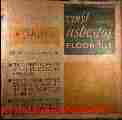
Details about Montgomery Ward vinyl asbestos tile flooring are at MONTGOMERY WARD ASBESTOS FLOOR TILE IDENTIFICATION. Excepts are below.
Sears & Roebuck asbestos-Containing Floor Tiles & Flooring, Photo Guide
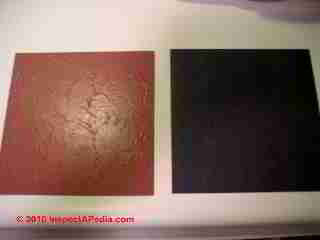
Details about Sears vinyl asbestos tile flooring are at SEARS ROEBUCK VINYL ASBESTOS FLOOR TILE RECOGNITION . Excepts are below.
Below our photographs show the embossed pattern on these Sears vinyl asbestos floor tiles. The tiles are solid through in color and material and are about 1/16" thick and 9" x 9" in size. Below right shows these Sears floor tiles installed.
(photos wanted for Sears Roebuck, Montgomery Ward and other asphalt & vinyl-asbestos floor tile producers or distributors - CONTACT US)
Armstrong Vinyl-Asbestos Floor Tile Photo ID Catalog - 1951 - 1986
Our photo above from Rosato, shows an Armstrong asphalt floor tile installation.
Our reproduction of vinyl-asbestos floor tile patterns and colors
at ASBESTOS FLOOR TILE IDENTIFICATION PHOTOS 1949-1959
selected representative images of each style or floor tile identification pattern in which tiles were produced. Within each pattern there were various colors available as well.
By minimizing repetition of patterns and colors, across the set of years we show at least one example of nearly every pattern and color produced for these floor tiles.
On occasion, the original flooring packaging or installation literature may be available for a given home: often an extra box of floor tiles was kept for future repairs.
The vinyl-asbestos floor tile package label information, combined with a simple comparison of tiles in the package with tiles installed in the building may be sound confirmation of asbestos-containing materials. See Vinyl Asbestos Floor Tile Packaging.
Historical information about the dates of flooring installation may also be sufficient to rule in or out the possibility that flooring in a building contains asbestos.
Where the same floor style pattern was produced for multiple years, in subsequent years we show other colors in which the tile pattern was made. Just scroll through this vinyl asbestos floor tile photo guide to find the first occurrence of each floor tile style, pattern, name, dimensions, and colors. Or if you know the approximate year that your floor was installed you can scroll down to that very year in our photo library.
It is instructive to take a close look at our tile photos from 1973 and 1974. Some floor tile colors and patterns, especially among the "standard" tiles, include both asphalt-based tiles and vinyl-asbestos tiles that look quite alike. But the combination of color, pattern, and size can help distinguish among these.
For example, "Standard Pattern" floor tiles were produced in both vinyl-asbestos form and in an asphalt tile without asbestos in 1973. But asphalt-based tiles that did not contain asbestos were produced in 1973 only in 9"x9". So flooring made for that year and particular pattern, the tile size provides important information.
Watch out: Because flooring products may have been produced in years earlier than the year of installation, don't assume that a floor installed in a building built shortly after 1980 could not possibly contain vinyl-asbestos product.
As we warned just above, don't assume that only "vinyl asbestos floor tiles" include asbestos.
Key to Thicknesses or Gauges of Vinyl-Asbestos Floor Tiles & Floor Tile Application or Usage by Thickness
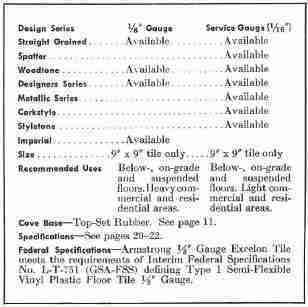
Vinyl Asbestos Floor Tile Thickness & Usage Guide
Shown at left is a vinyl-asbestos floor specification summary and usage guide from 1959 - Armstrong.
- For details see Asphalt & Vinyl Asbestos Floor Tile Dimensions - Floor tile dimensions, thicknesses & applications
...
Reader Comments, Questions & Answers About The Article Above
Below you will find questions and answers previously posted on this page at its page bottom reader comment box.
Reader Q&A - also see RECOMMENDED ARTICLES & FAQs
Question: Armstrong diecut inserts from around 1952 - ways to seal these floors?
Am looking for information on Armstrong diecut inserts from around 1952. Also are there any recommended ways to seal these floors so you can enjoy the look but without any asbestos concerns? Thanks, Sarah - Sarah 6/23/11
Reply: gentle cleaning followed by floor restorer clear coating protects from asbestos fiber release
Sarah:
Our photos show examples of some of the diecut flooring inserts from the 1950's; I'm not sure what other information you seek.
About sealing vinyl-asbestos tile floors, especially in residential use where school or public regulations and public access worries don't apply, I've had great success using clear-coating floor restorer products.
As you can see at ASBESTOS FLOORING LEFT IN PLACE, we just did this recently in a New York home. The floor was washed with mild detergent and water. Then we used a spray cleaner recommended by the floor resetorer manufacturer. The spray cleaner removes old wax residues. Next we used a magic marker to color in some gouges that had marred the floor surface. Finally we coated the flooring with the floor restorer product. The floor looked new, and great.
In sum, if you maintain a hard clear coating on top of the floor surface you won't be releasing any measurable level of asbestos fibers by normal foot traffic.
Also see ASBESTOS FLOORING HAZARD REDUCTION for more ways to reduce the asbestos hazard in asbestos-suspect or presumed asbestos-containing flooring.
Question
Found what I believe to be asbestos tiles under carpet in all 4 bedrooms of a house my daughter purchased. The house is 100 + age so this indicates these tiles would be asbestos. Some are damaged through age and also have been stapled to hold the underpad of carpeting and also the carpet tack around the edges. What is the hazard of the staples and tack? Should we be concerned about fiber leakage thru these holes and various damage in the rooms. Thank you - Leaha 9/7/11
Reply:
Leaha
Shile one cannot assert the age of a flooring material necessarily from the age of a house (as flooring can be installed long after original construction) it's reasonable to use caution about old-looking flooring in a 100 year old home before knowing much more.
But it's unlikely that there would be measurable asbestos particle movement up through wall to wall carpeting over floor tiles; the hazards would more likely arise during demolition.
See ASBESTOS FLOORING HAZARD REDUCTION (article link at the ARTICLE INDEX the bottom of this article ) for advice about minimizing the hazards should you need to remove material.
If nevertheless you are worried about the health and safety of building occupants, you'd want a professional inspection for all conditions there; a loose railing or step or a fire hazard could be a greater risk that should not go ignored. Finally, you could order asbestos tests on settled house dust or even air sampling if you are very anxious about the matter; frankly those steps would not be my first concern.
Question: identifying various other brands and product numbers of floor tiles
do you know if the SEARS brand HOMART 64-7169 asphalt floor tile contained asbestos? - Paul Wright 9/22/11
Have you heard of Dura Floor Plastic Asphalt Tiles? Do they contain asbestos? - Jo Lynn Judka 10/24/11
I have 12" x 12" tile in the basement just like the pattern San Roque Gold 57161 from 1980.
However, this tile is not 1/8 thick but 1/16 and it was peel & stick. Would this contain asbestos? - David 11/27/11
Is there a way I can forward someone a photo of a school floor to determine if it contains asbestos? I am unable to get back into the building It is closed, but the school dept wants to open it again and is saying that there isn't a problem. I looked through the tiles on your site, but oculdn't find an exact match. The school was built in 1950-1960, but we have no evidence that the tiles have been replaced. Can you help? -
we have an armstrong floor tile (black color) with the following numbers on the back L4 1230 021898. We don't know the year it was installed. Does it contain asbestos? Is there a way to cross reference these numbers? - Dan 5/1/12
We have the San Roque pattern sheet vinyl. Did Armstrong use the same patterns at a later date for their sheet vinyl but without asbestos? We have already started to remove it and I am concerned. - Sue 10/24/2012
We have vinyl sheet flooring that was put in about mid 1984. Is this anything to worry about? When exactly was asbestos banned in the manufacture of sheet flooring? - Peter 11/6/2012
Reply:
David, naturally by email alone no one can say with certainty whether or not a floor tile contains asbestos, but if your flooring matches one of the ACM floor tiles we illustrate here, AND if you are confident about the age (as you suggest) most likely it is an asbestos-containing product. And yes, for sure there were some peel-and-stick floor tiles that contained asbestos in the tile baking.
That does not necessarily mean that you need a costly asbestos remediation job - it depends on the condition of the surface, use made of the area, etc. If the floor is sound you may have the option of simply covering it with a new material.
JoLynn, sorry we don't have information about DuraFloor plastic asphalt tiles. Do you know the age of the product? You're welcome to send us photos (see the CONTACT link at top, side, bottom of our pages), and I'll research further. Certainly up to the early 1980's many asphalt floor tile products contained asbestos.
Dan, while we have published product and lot numbers for some floor tile products, there are just too many of them, thousands. Unlike mechanical equipment like water heaters or furnaces, I have not found a standard of correlation between product numbers and date of manufacture, though it probably was included in widely varying ways by individual manufacturers.
You can narrow down the asbestos question by:
- noting the age of the building itself as that sets the earliest plausible date for its floor materials +/- a year or so to allow for flooring sold from stock
- noting the date of any renovations of the building
- noting whether or not there are multiple layers of flooring or other similar changes that give a renovation history
- noting information on any packaging used for the floor tiles - sometimes an extra box of floor tiles is left and stored in a building, intended to supply future repairs or changes to the floor
- comparing the appearance of your flooring to the photographs we provide in these tile identification articles
- sending a small sample of flooring to a certified asbestos testing lab
For a tile floor of unknown constituents, do not do something foolish such as grinding, sanding, power sawing, or a dusty messy demolition.
Peter,
I think you mngh want to ask Armstrong, but in NY case, if you remove materials following the recommended procedures and avoid making a dusty ness you should be OK
Question: risk assessment for demolished asbestos-suspect flooring
Hi there, being naive and not aware that floor tiles may contain asbestos - I began removing some older tiles from under the carpet in my kids room. After seeing a warning on a Home Depot website - we stopped the removal. Is there any way of testing or visually confirming the possibility of it containing asbestos? I was working in the area for approximately 2 hours without any breathing apartus, etc. What are my options at this point? My wife is freaking out. Thanks - Sean M 1/22/12
Reply:
At ASBESTOS TESTING LAB LIST you can see how to choose and contact a certified asbestos testing lab to have a sample of your flooring tested for asbestos content. If the home may have been contaminated, dust testing, air testing, and professional cleanup might be appropriate.
Question: having trouble identifying my floor tile
I think I've looked through all the photos here and fortunately, the only one that appears to resemble what I have is in the "1989 & Later Armstrong Accoflex Series Flooring Tiles" image just above this comment box.
UNfortuneately, it is very difficult to be sure from this small image and i am sure what I have is NOT from the UK. The tiles I have are 12" x 12", 1/8" thick light blue and white (like streaked clouds on a blue sky) resembling "Spruce" above. The tiles are VERY heavy, quite inflexible and have very tiny sparkling crystals throughout.
These physical apsects make me very uneasy. Since the tiles are at least 25 years or more old, should I be concerned? Where might I go for an expert opinion? Thanks. - Scott 2/1/2012
Reply:
Scott if you can't convince yourself that you've found the exact floor tile in your home shown among the example photos in our asbestos floor reference libraries here, your best bet may be to either
- have a sample tested by a certified asbestos test lab
or
- given the age of the flooring, treat the flooring as PACM - presumed asbestos containing material and handle it with appropriate precautions. Heroic measures are rarely needed for flooring materials.
Question: How much asbestos hazard was I exposed to during our floor renovation project?
We recently partially demo'd a ceramic tile floor in the kitchen of a home built in 1970. We popped the ceramic tiles up with a pry bar and sledge hammer. Beneath the tiles was a linoleum floor covering. I've visually identified the flooring on your website. It is Armstrong, Excelon, Custon Burnham 1972, 57080 Blue. How much asbestos does this contain?
Also, we didn't bother peeling it all up because it was too difficult.
We chipped up the remaining ceramic tile on top of it and just covered the remainder of the floor with plywood and fastened the plywood with split drive fasteners.
We then nailed pine plank flooring over the plywood. Do we have any reason to worry about asbestos exposure??? My husband wore a dust mask. - Kelly McCullin 11/13/2012
I have ArmStrong sheet layment in my kicten.There was a layer of newer layment on top I did realize it was the orignal under it. The house was built in 1974. I removed about a there foot area before I realized it. If i was exsposed to it how much does it take to make you sick and what are the symptoms.I have to think I am not the only one who has done this. - David 11/28/2012
Reply: it depends ... Here is a list of some risk factors when removing flooring that may contain asbestos
David, and also Kelly McKullin:
Unfortunately no one can say with any accuracy whatsoever just what level of hazard you were exposed to during your asbestos floor removal. The variables include:
- the total amount of material disturbed and removed
- the actual asbestos content of the flooring and of other materials, such as mastic, that were disturbed
- the removal methods used to take up flooring, and just how much dust you created
- nature of demolition dust and debris - particle size, therefore airborne particulate levels & duration of particles in the air. For example, picking up a whole floor tile that is already loose may produce almost no detectable airborne particulates, while running power tools, saws, grinders, sanders, hammers, can make a lot of dust
- dust control measures used during the project
- cleanup methods used after the project both in and out of the work area
- remaining dust that could have led to longer term exposure
- individual health history, respiration rate, personal protective gear used or not
- other site & individual -specific data not listed here
If you have specific individual health questions those should be posed to your doctor who knows your personal health history
Presuming that your project is now long over, if you have reason to be concerned, you might want to do some strategic dust sampling to see whether or not the building needs further cleanup
See ASBESTOS REMOVAL GUIDE, FLOORING and ASBESTOS REMOVAL, WETTING GUIDELINES
Question: what are the wisdom & morality of walking away from a home & mortgage for a property with asbestos-containing flooring?
If an unsuspecting home owner was sold a house containing asbestos floors that are friad, would it be immoral to walk away from the mortgage? - Kim 1/14/2013
Reply:
Kim, in my OPINION, it would be immoral and also stupid.
Failure to disclose: it would without question be immoral for a seller or agent to fail to disclose to the buyer a known and substantive economic, health, or safety condition at a home, but sadly that event happens every day, excused by disclaimers and exclusion fees. Caveat emptor.
Walking away from a mortgage: Though philosophers would express a more expertly-reasoned view, mine is that the presumption that a bank is adequately compensated for an abandoned mortgage by receiving back the collateral property is a tenuous one.
In the Bush era 2008 housing mortgage collapse in the U.S., mortgage originating agents for lenders wrote mortgages that they knew could not be carried by the recipient, receiving their up-front fees, commissions, and profits without regard for what would follow.
Banks in turn re-packaged the bad loans, hid their poor quality, and re-sold them to investors including private investors. Investors depended on rating agencies who in turn succumbed to conflicts of interest as they relied on fees from the banks or investments they rated.
Ultimately it was large and small investors who lost some or all of their life savings, retirement pensions &c. Mortgage writers, banks, and legislators in the "too big to fail club" got still bigger during the bank bailout and can continue to count on the middle-income taxpayer to bear the ultimate expense of over-valued abandoned properties.
Would prefer to live in a world where anyone, at any time, could simply dump costs she didn't want to pay onto strangers? Can you imagine yourself as the stranger having to bear those costs?
Abandoning a home with asbestos-containing floors: And walking away from a home with asbestos-containing flooring would be stunningly stupid as well. The probability that the costs associated with asbestos-containing flooring would make up even one percent of the value of a home is close to zero. - DF.
Question: does this floor covering contain asbestos ? photo attached.
I came across your website and was hoping you might be able to help me identify this flooring for asbestos.
I have attatched a picture [at elft]. Thank you! J. DF. 3/17/2013
Reply:
Because of the production of some common paterns of flooring across many years, it is probably at least equally important to have an idea when the floor of concern to you was installed and also whether it is made of individual tiles or is sheet flooring.
In your photo the material looks like sheet flooring not tiles but I'm not certain. If your floor covering is not glued to the subfloor, look on the back of the flooring for an Armstrong logo or trademark, and check out very similarly-designed floor tile patterns by that company in the Execelon line beginning around 1972 - see the Custom San Pedro floor tile examples such as Excelon 54480 green or Excelon 57070 white for examples.
That popular floor tile pattern may well have been carried over into sheet flooring products made later and that may include your example above.
Test Results for Armstrong Sheet Flooring - 70% Asbestos
Moved to ASBESTOS TEST RESULTS for TILE & SHEET FLOORING
...
Continue reading at ASBESTOS FLOOR TILE IDENTIFICATION PHOTOS 1949-1959 or select a topic from the closely-related articles below, or see the complete ARTICLE INDEX.
Or see these
Recommended Articles
- ASBESTOS DISPOSAL REGULATIONS
- ASBESTOS FLOOR TILE COMPOSITION
- ASBESTOS FLOORING DAMAGE HAZARDS
- ASBESTOS FLOORING HAZARD LEVEL ASSESSMENT
- ASBESTOS FLOORING HAZARD REDUCTION
- ASBESTOS FLOOR TILE IDENTIFICATION COLOR KEY - home
- ASBESTOS FLOORING IDENTIFICATION GUIDE INDEX - all brands, all years
- ASBESTOS FLOORING REMOVAL GUIDE
- ASBESTOS REMOVAL, WETTING GUIDELINES
- ASBESTOS RISK ASSESSMENT
- ASBESTOS TEST RESULTS for TILE & SHEET FLOORING
- ASBESTOS TESTING LAB LIST
- DOES THIS FLOOR CONTAIN ASBESTOS? - 5 easy questions to tell if your FLOOR probably contains asbestos -
- DOES THIS MATERIAL CONTAIN ASBESTOS? - 5 easy questions to tell if a BUILDING MATERIAL probably contains asbestos -
- HAZARD vs RISK - what's the difference, why you should care
Suggested citation for this web page
ASBESTOS FLOOR TILE PRODUCT NAMES at InspectApedia.com - online encyclopedia of building & environmental inspection, testing, diagnosis, repair, & problem prevention advice.
Or see this
INDEX to RELATED ARTICLES: ARTICLE INDEX to ASBESTOS HAZARDS
Or use the SEARCH BOX found below to Ask a Question or Search InspectApedia
Ask a Question or Search InspectApedia
Try the search box just below, or if you prefer, post a question or comment in the Comments box below and we will respond promptly.
Search the InspectApedia website
Note: appearance of your Comment below may be delayed: if your comment contains an image, photograph, web link, or text that looks to the software as if it might be a web link, your posting will appear after it has been approved by a moderator. Apologies for the delay.
Only one image can be added per comment but you can post as many comments, and therefore images, as you like.
You will not receive a notification when a response to your question has been posted.
Please bookmark this page to make it easy for you to check back for our response.
IF above you see "Comment Form is loading comments..." then COMMENT BOX - countable.ca / bawkbox.com IS NOT WORKING.
In any case you are welcome to send an email directly to us at InspectApedia.com at editor@inspectApedia.com
We'll reply to you directly. Please help us help you by noting, in your email, the URL of the InspectApedia page where you wanted to comment.
Citations & References
In addition to any citations in the article above, a full list is available on request.
- [1] Armstrong ® Residential Flooring - Website 05/15/2010 https://www.armstrongflooring.com/ lists current flooring products provided by the Armstrong Corporation, including Armstrong's current vinyl floor tile products at https://www.armstrongflooring.com/flooring/products/vinyl-floors
- [2] Armstrong Corporation, Corporate History - https://www.armstrongflooring.com/corporate/corporate-history.html - Web Search 05/19/2010
- [3] Armstrong vinyl asbestos floor tiles: photos of asbestos-vinyl floor tiles as catalog pages (PDF form) are at www.asbestosresource.com/asbestos/tile.html
- [4] Accoflex 2005 series semi-flexible vinyl tile Wonder flooring product description; Armstrong's Accoflex is a vinyl composition floor tile. WonderFlooring, Private Bag X02, Fordsburg 2033, Telephone: 011 298 8100, Fax: 011 836 4450, National Call Centere: 0860-29-80-80, Email: info@wonderflooring.com & marketing@wonfloor.com/ [2nd is a defective email address]
Web search 01/29/2011, original source: http://www.wonderflooring.com/accoflex/accoflextech2.pdf
Reference: Armstrong Flooring: Accotile, Accoflex & Coke Tile. Publication 333, Armstrong Flooring.
Note on use of the "Accoflex" name:
In addition to Accoflex flooring produced by Armstrong, Accoflex® is also a U.S. registered trademark used for Insulation Jackets For Industrial Pipes, Tanks and Conduits Including Flexible and Rigid Insulation In the Form of Foamed Synthetic Material Sheeting, owned by Armacell Enterprise Gmbh, Armstrong World Industries, Inc, also distributed in the U.K., Australia, & New Zealand, also in Indonesia. Armacell Australia Pty Ltd, a producer of engineered foams, (http://www.armacell.com/) was founded officially in August 2000 when the then Armstrong Insulation Products (Australia) became a separate legal entity from Armstrong World Industries group. - [5] "Asbestos in your home or at work," Forsyth County Environmental Affairs Department, Winston-Salem NC 12/08
- [6] "Asbestos Floor Tile Removal", the University of Minnesota's advice on removing VAT (vinyl asbestos or asphalt asbestos floor tile) can be read in detail at www.health.state.mn.us/divs/eh/asbestos/floortile/index.html
- [7] Copy on file as ASBESTOS IN YOUR HOME - U.S. EPA, Exposure Evaluation Division, Office of Toxic Substances, Office of Pesticides and Toxic Substances, U.S. Environmental Protection Agency, Washington,D.C. 20460
- [8] Resilient Floor Covering Institute, 1030 15th St. NW, suite 350, Washington D.C.
- [9] Inspiring Interiors from Armstrong 1950s from Armstrong, [Paperback], Schiffer Publishing (March 1998), ISBN-10: 0764304585, ISBN-13: 978-0764304583
- [1] Interior Solutions from Armstrong the 1960s from Armstrong, [Paperback], Schiffer Publishing (March 1999), ISBN-10: 0764307002, ISBN-13: 978-0764307003
- [10] Mechanix Illustrated How-to-do-it Encyclopedia Vol 2. -1961
- [11] Asbestos products and their history and use in various building materials such as asphalt and vinyl flooring includes discussion which draws on ASBESTOS, ITS INDUSTRIAL APPLICATIONS, ROSATO 1959, D.V. Rosato, engineering consultant, Newton, MA, Reinhold Publishing, 1959 Library of Congress Catalog Card No.: 59-12535 (out of print).
- [12] Congoleum Corporation, "Company History", Congoleum Corporation, Department C, P.O. Box 3127, Mercerville, NJ 08619-0127 1-609-584-3601, web-search 03/14/2011, original source: http://www.congoleum.com/history.html
- [13] David Grudzinski, Advantage Home Inspections, is a professional home inspector in Cranston, RI. 02910. He can be reached at 401-935-6547, fax- 401-490-0607 or by email to contact/us@advantagehomeinspections.us 04/26/2009
- [14] EPA Guidance for Controlling Asbestos-Containing Materials in buildings, NIAST, National Institute on Abatement Sciences & Technology, [republishing EPA public documents] 1985 ed., Exposure Evaluation Division, Office of Toxic Substances, Office of Pesticides and Toxic Substances, U.S. Environmental Protection Agency, Washington,D.C. 20460
- [15] EPA ASBESTOS MATERIALS BAN: CLARIFICATION 1999
- [16] EVER WEAR TILE CO is currently (2009) in the Terrazzo, Tile, Marble, and Mosaic Work industry in Fallon, NV. 775) 423-6221. [We do not know the company history nor whether there is an association with EverWear vinyl asbestos floor tiles discussed in this article.]
- [17] Kentile KenFlex flooring photographs:Flickr web search 5/15/2010 - see original material and other asbestos product photos
- [18] "Plastic Flooring Spreads Through the House", Jackson Hand, Guide to Home-Improvement Materials, Popular Science, April 1969, p. 154-158
- [19] Thomas Hauswirth, Managing Member of Beacon Fine Home Inspections, LLC and (in 2007) Vice President, Connecticut Association of Home Inspectors Ph. 860-526-3355 Fax 860-526-2942 beaconinspections@sbcglobal.net 06/07: thanks for photographs of transite asbestos heating ducts
- [20] Gary Randolph, Ounce of Prevention Home Inspection, LLC Buffalo, NY, for attentive reading and editing suggestions. Mr. Randolph can be reached in Buffalo, NY, at (716) 636-3865 or email: gary@ouncehome.com 3/07
- [21] Thanks to reader Matt Abel, Design Services Department, Strongwood Log Home Company, 711 Shadow Road, Waupaca WI 54981, Office (715) 258-4818, Toll Free (866) 258-4818, www.gostrongwood.com "Begin your journey home.." for vinyl asbestos floor photos, October 2010.
- [22] Thanks to reader Meryl Silvers for hexagonal floor tile photos showing a possilbe Kentile product that contained asbestos. October 2010.
- [23] Thanks to reader N.H. for providing a photo of 1970's era vinyl asbestos floor tile that we identify as most likely Armstrong Solarian Devonport white.
- [24] M.B. provided photographs of Congoleum linoleum flooring from a 1960's Tampa Florida home.
- [25] L.R. provided photographs of Armstrong Palimino Beige and Pecan Beige asphalt asbestos floor tiles, floor tile packaging and identification details, along with asbestos test lab results. Personal correspondence with DF, 10/22/2012
- [26] Window Putty - OSHA case cites contractor for asbestos exposure during removal of window putty http://www.osha.gov/pls/oshaweb/owadisp.show_document?p_table=NEWS_RELEASES&p_id=1091 June 1997 -
- Asbestos Identification and Testing References
- [27] Asbestos Identification, Walter C.McCrone, McCrone Research Institute, Chicago, IL.1987 ISBN 0-904962-11-3. Dr. McCrone literally "wrote the book" on asbestos identification procedures which formed the basis for current work by asbestos identification laboratories.
- [28] Stanton, .F., et al., National Bureau of Standards Special Publication 506: 143-151
- [20] Pott, F., Staub-Reinhalf Luft 38, 486-490 (1978) cited by McCrone
- [30] ASBESTOS IN YOUR HOME U.S. EPA, Exposure Evaluation Division, Office of Toxic Substances, Office of Pesticides and Toxic Substances, U.S. Environmental Protection Agency, Washington,D.C. 20460
- Asbestos products and their history and use in various building materials such as asphalt and vinyl flooring includes discussion which draws on ASBESTOS, ITS INDUSTRIAL APPLICATIONS, ROSATO 1959, D.V. Rosato, engineering consultant, Newton, MA, Reinhold Publishing, 1959 Library of Congress Catalog Card No.: 59-12535 (out of print, text and images available at InspectAPedia.com).
- [31] "Handling Asbestos-Containing roofing material - an update", Carl Good, NRCA Associate Executive Director, Professional Roofing, February 1992, p. 38-43
- [32] EPA Guidance for Controlling Asbestos-Containing Materials in buildings, NIAST, National Institute on Abatement Sciences & Technology, [republishing EPA public documents] 1985 ed., Exposure Evaluation Division, Office of Toxic Substances, Office of Pesticides and Toxic Substances, U.S. Environmental Protection Agency, Washington,D.C. 20460
- In addition to citations & references found in this article, see the research citations given at the end of the related articles found at our suggested
CONTINUE READING or RECOMMENDED ARTICLES.
- Carson, Dunlop & Associates Ltd., 120 Carlton Street Suite 407, Toronto ON M5A 4K2. Tel: (416) 964-9415 1-800-268-7070 Email: info@carsondunlop.com. Alan Carson is a past president of ASHI, the American Society of Home Inspectors.
Thanks to Alan Carson and Bob Dunlop, for permission for InspectAPedia to use text excerpts from The HOME REFERENCE BOOK - the Encyclopedia of Homes and to use illustrations from The ILLUSTRATED HOME .
Carson Dunlop Associates provides extensive home inspection education and report writing material. In gratitude we provide links to tsome Carson Dunlop Associates products and services.


